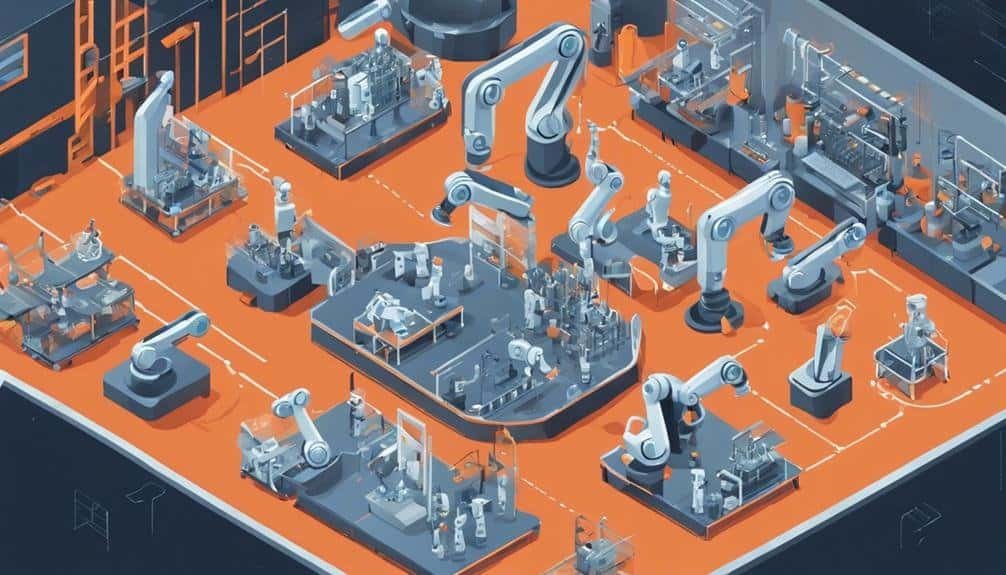AI in Manufacturing Efficiency and Innovation: A Practical Guide
Imagine a bustling factory floor where machines hum with precision, seamlessly orchestrating a symphony of production. In the realm of AI in manufacturing, efficiency and innovation intertwine to redefine the landscape of production processes.
From predictive maintenance to robotics integration, the possibilities seem boundless. As you navigate through the practical guide ahead, you'll uncover how AI not only streamlines operations but also paves the way for unprecedented advancements in quality control and decision-making.
Get ready to witness how AI transforms the manufacturing realm into a realm of endless possibilities.
Key Takeaways
- AI in manufacturing enhances operational efficiency and quality control.
- Predictive maintenance and defect detection prevent breakdowns and improve product quality.
- Supply chain optimization through AI streamlines operations and boosts decision-making.
- Overcoming challenges like data quality and employee training is crucial for successful AI implementation.
Evolution of AI in Manufacturing
In the realm of manufacturing, AI has undergone a transformative evolution, revolutionizing processes and propelling efficiency to unprecedented levels. The evolutionary trends of AI in manufacturing have been shaped by rapid technological advancements. Initially, AI applications in manufacturing were limited to basic tasks such as data collection and analysis. However, with the progression of technology, AI has evolved to encompass a wide range of complex functions, including predictive maintenance, quality control, and even autonomous robotic systems.
Technological advancements have played a crucial role in this evolution, enabling AI systems to process vast amounts of data in real-time, identify patterns, and make informed decisions with minimal human intervention. Machine learning algorithms have become increasingly sophisticated, allowing AI to continuously learn and adapt to new challenges and scenarios in the manufacturing environment. As a result, manufacturers are now able to optimize production processes, reduce downtime, and improve product quality through the strategic implementation of AI technologies. This evolution signifies a shift towards more intelligent, efficient, and data-driven manufacturing operations.
Benefits of AI Implementation
When implementing AI in manufacturing, you can expect enhanced production processes that streamline operations and boost output efficiency.
Additionally, AI enables improved quality control measures through advanced predictive analytics and real-time monitoring, ensuring product consistency.
These benefits translate into reduced downtime, minimized defects, and ultimately, increased profitability for your manufacturing operations.
Enhanced Production Processes
Maximizing operational efficiency and output levels, AI implementation in manufacturing revolutionizes production processes by streamlining workflows and optimizing resource utilization. Through process automation, AI eliminates repetitive tasks, reducing human error and enhancing efficiency. By analyzing vast amounts of data in real-time, AI can predict maintenance needs, preventing costly downtime. Furthermore, AI-driven predictive analytics allows for proactive decision-making, optimizing production schedules and inventory management. The table below highlights key benefits of AI in enhancing production processes:
| Benefits of AI in Production Processes |
|---|
| Streamlining workflows |
| Optimizing resource utilization |
| Predictive maintenance |
Implementing AI in production processes results in increased productivity, minimized waste, and enhanced competitiveness in the dynamic manufacturing landscape.
Improved Quality Control
Enhancing manufacturing processes with AI implementation leads to superior quality control by leveraging advanced technology for precise and efficient monitoring.
AI plays a crucial role in defect detection, enabling real-time identification of irregularities in products during the manufacturing process. Through machine learning algorithms, AI can analyze vast amounts of data to detect even the smallest deviations from quality standards, ensuring that only flawless products reach the market.
Moreover, AI enhances product inspection by automating the assessment of various quality parameters, such as dimensions, color consistency, and surface defects. By integrating AI into quality control processes, manufacturers can significantly reduce human error, improve overall product quality, and enhance customer satisfaction.
Predictive Maintenance Solutions
When considering predictive maintenance solutions in manufacturing, the focus should be on early fault detection to prevent costly breakdowns. Implementing equipment health monitoring systems can optimize machine performance and increase longevity. It is also crucial to employ downtime reduction strategies to ensure continuous production efficiency.
These three key aspects work together to create a comprehensive approach to predictive maintenance in manufacturing. By combining early fault detection, equipment health monitoring, and downtime reduction strategies, companies can improve operational efficiency and minimize disruptions in production.
Early Fault Detection
Implementing early fault detection systems in manufacturing plants can significantly reduce downtime and maintenance costs. By utilizing advanced technologies such as machine learning and neural networks, these systems can identify anomalies in equipment behavior, allowing for timely intervention before failures occur. This proactive approach not only prevents unexpected breakdowns but also optimizes maintenance schedules, avoiding unnecessary servicing. Below is a table highlighting the key benefits of early fault detection in manufacturing:
| Benefits of Early Fault Detection | ||
|---|---|---|
| Reduced Downtime | Cost Savings | Improved Productivity |
| Prevents Major Failures | Enhanced Safety | Extended Equipment Lifespan |
| Optimized Maintenance | Increased Efficiency | Data-Driven Decision Making |
Equipment Health Monitoring
Equipment health monitoring in manufacturing involves the continuous collection and analysis of data from machinery to predict maintenance needs and prevent unexpected breakdowns. When it comes to optimizing equipment performance and minimizing downtime, proactive maintenance strategies are key.
Utilizing remote monitoring tools can offer real-time insights into the health and performance of your machinery, allowing for timely interventions before failures occur. By implementing predictive maintenance solutions, you can shift from reactive to proactive maintenance practices, saving time and costs associated with unplanned downtime.
Here are three crucial aspects of equipment health monitoring:
- Real-time data analysis for early fault detection
- Integration of AI algorithms for predictive maintenance
- Remote monitoring for instant diagnostics and decision-making
Downtime Reduction Strategies
Deploying predictive maintenance solutions in manufacturing operations optimizes machinery uptime, streamlines maintenance processes, and enhances overall equipment reliability.
By implementing proactive maintenance strategies, manufacturers can significantly reduce downtime by predicting when equipment failures might occur and taking preemptive actions. This approach not only minimizes costly unplanned downtime but also boosts operational efficiency by ensuring that machinery runs smoothly without unexpected interruptions.
Predictive maintenance solutions utilize data analytics and machine learning algorithms to monitor equipment health in real-time, enabling timely interventions before breakdowns happen.
Ultimately, this proactive approach to maintenance leads to increased productivity, improved equipment longevity, and higher overall operational efficiency in manufacturing facilities.
Enhancing Quality Control With AI
Utilizing AI technology for quality control processes in manufacturing can significantly enhance efficiency and accuracy. When it comes to enhancing quality control with AI, there are several key aspects to consider:
- Automated Defect Detection: AI systems can identify defects in real-time, allowing for immediate corrective actions to be taken, reducing the likelihood of defective products reaching the market.
- Real-Time Analysis: AI enables continuous monitoring and analysis of production processes, providing instant feedback on quality issues and allowing for quick adjustments to maintain high standards.
- Quality Assurance with Machine Learning Algorithms: Machine learning algorithms can be trained on vast amounts of data to predict potential quality issues, optimizing quality control processes and ensuring consistency in product quality.
Streamlining Supply Chain Operations
To optimize manufacturing processes further, consider integrating AI solutions to streamline supply chain operations, enhancing efficiency and responsiveness across the entire production cycle.
Supplier collaboration plays a crucial role in ensuring smooth supply chain operations. AI can help in establishing real-time communication channels with suppliers, enabling better coordination, inventory management, and timely deliveries.
By analyzing historical data and market trends, AI algorithms can enhance demand forecasting accuracy. This capability allows manufacturers to anticipate fluctuations in demand, optimize inventory levels, and reduce stockouts or overstock situations.
Improved demand forecasting leads to enhanced production planning and resource allocation, ultimately increasing operational efficiency and reducing costs.
Additionally, AI can provide valuable insights into supplier performance, quality control, and potential risks, enabling proactive measures to mitigate disruptions.
AI-driven Production Optimization
Enhance production efficiency and quality through AI-driven optimization techniques. When it comes to AI-driven production optimization, integrating machine learning into manufacturing processes can yield significant benefits. Smart factory solutions offer real-time monitoring capabilities, allowing for agile decision-making and proactive adjustments.
Here are three key aspects to consider in AI-driven production optimization:
- AI driven process optimization: Utilize artificial intelligence algorithms to analyze production data and identify areas for improvement automatically.
- Machine learning integration: Incorporate machine learning models to predict maintenance needs and optimize production schedules based on historical data.
- Real-time monitoring capabilities: Implement systems that provide instant feedback on production processes, enabling quick responses to deviations and ensuring consistent quality output.
Robotics and Automation Integration
By integrating robotics and automation into manufacturing processes, you can further optimize production efficiency and quality. Robotics integration offers a way to streamline repetitive tasks, enhance precision, and increase output capacity. Automation solutions, when strategically implemented, can lead to reduced lead times, minimized errors, and improved resource utilization. Embracing innovation strategies through robotics and automation integration empowers manufacturers to stay competitive in today's fast-paced market.
Efficiency optimization becomes achievable through the seamless coordination of robotic systems with existing manufacturing workflows. By automating routine operations, companies can free up human resources for more complex tasks that require creativity and problem-solving skills. Moreover, the implementation of automation solutions enables continuous production cycles, reducing downtime and enhancing overall productivity levels. Integrating robotics and automation not only boosts operational efficiency but also elevates the standard of products by ensuring consistency and precision throughout the manufacturing process.
Data Analytics for Decision Making
Utilize data-driven decision-making processes in manufacturing to enhance operational efficiency and strategic planning.
Employ statistical analysis to derive actionable insights from large datasets, enabling informed choices.
Implement predictive modeling applications to forecast trends, optimize production processes, and mitigate potential risks.
Data-Driven Decision-Making Processes
Implementing data-driven decision-making processes in manufacturing can significantly enhance operational efficiency and drive innovation. By leveraging machine learning algorithms and data visualization techniques, you can extract valuable insights from your manufacturing data to make informed decisions.
Here are three key benefits of adopting data-driven decision-making processes:
- Improved predictive maintenance strategies based on machine learning algorithms.
- Enhanced quality control through real-time data visualization and analysis.
- Optimal resource allocation by utilizing data-driven insights to streamline production processes.
These approaches empower you to optimize operations, reduce downtime, minimize waste, and ultimately boost productivity in your manufacturing facility. Embracing data-driven decision-making is the cornerstone of modern manufacturing efficiency and innovation.
Statistical Analysis for Insights
Engage in statistical analysis to gain valuable insights for making data-driven decisions in manufacturing. By analyzing data using statistical methods, you can uncover trends, patterns, and correlations that lead to process optimization and root cause analysis. Statistical tools like regression analysis, hypothesis testing, and correlation analysis can provide crucial insights into improving efficiency and quality in manufacturing processes.
| Statistical Analysis Methods | Description | Benefits |
|---|---|---|
| Regression Analysis | Examines relationships between variables | Predictive capabilities for process improvement |
| Hypothesis Testing | Tests assumptions about data | Validates decisions based on data |
| Correlation Analysis | Identifies relationships between variables | Helps in understanding cause-and-effect relationships |
Utilizing statistical analysis empowers you to make informed decisions backed by data, driving continuous improvement in manufacturing operations.
Predictive Modeling Applications
To enhance decision-making processes in manufacturing, explore the realm of predictive modeling applications, specifically focusing on data analytics for informed strategic choices.
Utilizing machine learning techniques can help predict equipment failures before they occur, optimizing maintenance schedules and reducing downtime.
Implementing predictive maintenance strategies based on historical data can improve overall equipment effectiveness by identifying patterns that lead to breakdowns.
By employing advanced algorithms, manufacturers can forecast production levels accurately, enabling proactive adjustments to meet demand fluctuations.
Enhance your manufacturing efficiency through predictive modeling applications that leverage data analytics to drive informed decisions and stay ahead of operational challenges.
AI Applications in Inventory Management
In modern manufacturing processes, AI revolutionizes inventory management through predictive analytics and automated replenishment systems. AI in inventory optimization enhances efficiency by analyzing historical data to forecast demand accurately.
Real-time tracking solutions enable proactive inventory management, reducing stockouts and overstock situations. By utilizing AI algorithms, manufacturers can determine optimal inventory levels, reorder points, and lead times, streamlining operations and minimizing carrying costs. These AI applications not only enhance decision-making but also improve overall supply chain performance.
With AI-driven inventory management, you can achieve cost savings, increased productivity, and better customer satisfaction. The ability to automate routine tasks such as inventory monitoring and ordering empowers employees to focus on strategic activities, driving innovation and growth.
Overcoming Challenges in AI Adoption
Manufacturers often encounter hurdles when integrating AI solutions, necessitating strategic approaches to successfully navigate the complexities of AI adoption in manufacturing processes. When facing AI implementation challenges, solutions are essential for a smooth transition. To overcome adoption barriers, strategies must be tailored to fit the specific needs of the manufacturing environment.
- Data Quality: Ensuring data accuracy and integrity is crucial for AI success. Implement data validation processes to maintain high-quality datasets.
- Employee Training: Providing comprehensive training programs for staff members is vital to enhance AI utilization. Invest in upskilling initiatives to empower employees with the necessary AI knowledge.
- Interdepartmental Collaboration: Foster collaboration between different departments to ensure a cohesive AI implementation strategy. Encourage communication and teamwork to maximize the benefits of AI technology across the organization.
Conclusion
In conclusion, embracing AI in manufacturing isn't just a trend, but a necessity for staying competitive in the industry.
By leveraging predictive maintenance, quality control, supply chain optimization, robotics, data analytics, and inventory management, companies can achieve unprecedented levels of efficiency and innovation.
While challenges may arise, the benefits of AI adoption far outweigh the risks.
It's time to take the leap and revolutionize your manufacturing processes with AI technology.
The future of manufacturing is here, are you ready to seize it?







